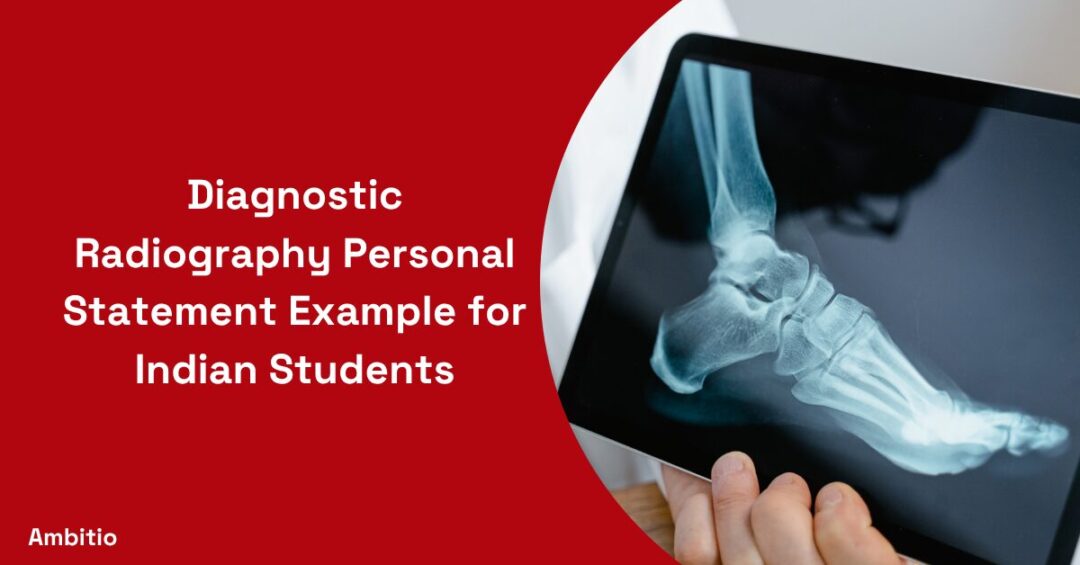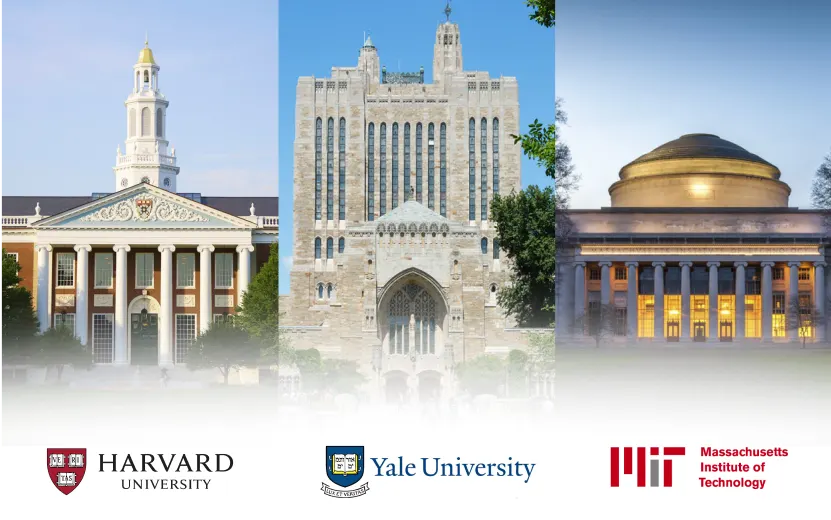28 May 2025
5 minutes read
Diagnostic Radiography Personal Statement Example for Indian Students

Key Takeaways
- Diagnostic radiography personal statement should highlight relevant skills, patient care experience, and a strong passion for radiography as a career.
- Diagnostic radiography personal statement must reflect personal experiences, communication skills, and suitability for advanced imaging programs.
- Diagnostic radiography personal statement helps demonstrate your motivation, understanding of the medical field, and readiness for clinical placement.
Each student has a history, and for Indian students to become diagnostic radiographers, their path combines science, empathy, and meaning. This sample personal statement explores the reasons and goals of selecting radiography as a profession.
It emphasizes key characteristics such as communication skills, patient care, and personal experiences working in the medical field. The objective? To motivate and assist those writing their own individual statement to present themselves as fit for a radiography course.
Focusing on personal attributes, applicability skills, and practical experience, this sample creates clarity for anyone who wants to gain entry into a prestigious radiography department overseas.
What is Radiography and Radiology?
Did you know that Wilhelm Röntgen discovered X-rays by accident in 1895?

Radiography and radiology have since become cornerstones in the diagnosis and treatment of diseases and injuries.
- Radiography uses the use of radiation to create images of the internal body.
- Radiologists interpret these images, often using advanced imaging techniques.
- Diagnostic-radiography includes X-rays, CT scans, and MRI.
- It plays a crucial role in hospital based and clinical placement environments.
- Radiography supports diagnosis and care for patients in nearly every medical sector.
How to Become a Radiographer?
Fun fact: The term “radiographer” originated in the early 20th century, but the profession has evolved dramatically with tech.
- Secure a high school diploma with core science subjects.
- Take competitive exams like ACT, IELTS, TOEFL, GRE, SAT, or GMAT depending on your chosen university.
- Apply through portals like UCAS for UK or directly to universities in Canada.
- Consider schools like University of Toronto, Dalhousie University, McGill University, University of Alberta, Western University, and University of British Columbia.
- Complete a degree in diagnostic-radiography with practical training in radiography.
| Step | Details |
|---|---|
| 1 | Complete high school with Biology, Physics, Chemistry |
| 2 | Appear for IELTS/TOEFL or other required tests |
| 3 | Apply to universities and colleges offering radiography |
| 4 | Enroll in a radiography program |
| 5 | Complete clinical placements and get certified |
How to Write a Diagnostic Radiography Personal Statement?
Guess what? Over 90% of UCAS applicants say writing the statement was the hardest part of their application.
- Begin with a personal hook or anecdote to express your passion for radiography and demonstrate your suitability for the program.
- Include your work experience in a radiology department or any medical environment.
- Highlight personal qualities such as a caring nature, humanitarian outlook, and team work towards the domain of injuries and diseases.
- Mention specific skills like communication and practical knowledge.
- Refer to experiences from your personal life that shaped your choice to study radiography as a career.
| Element | What to Include |
| Opening | Personal story or turning point |
| Skills | Team work, attention to detail, empathy and care for people |
| Experience | Hospital based exposure or internships and other relevant skills |
| Motivation | Why you feel that radiography is your career path |
| Conclusion | Summarize professional goals and suitability |
Radiography Personal Statement Example
Did you realize that radiography was one of the most popular allied-health occupations during the pandemic? This sample statement demonstrates a student’s great passion for radiography and describes their professional and academic experience.

Beginning well, this student expresses their early interest in x-rays and explains how a hospital visit changed their career choice to become a qualified radiographer.
Sample Personal Statement
I was amazed as a child by the images doctors would view in the human body with glowing light. That fascination blossomed into a career in radiography when I spent time volunteering at a hospital in Mumbai. I saw how skilled radiographers reconciled sophisticated imaging methods with empathetic care for patients. That’s when I knew I wanted to be a radiographer.
I worked hard at science subjects throughout high school to secure the best marks. From open days and workshops on nuclear medicine and radiography, I learned about the radiography department’s essential function. I had hands-on experience by shadowing practice radiographers at a private diagnostic center, observing the use of CT scans and the importance of communication in contact with the patient.
In addition to academic excellence, my humanitarian outlook drives me to help people through medical practice. I contribute to online journals on diagnostic radiography, and I have also taken part in virtual training in diagnostic radiography sessions.
Radiography, to me, is not just a career; it is a combination of science and compassion. I want to pursue radiography both to excel in advanced imaging and to make valuable contributions to diagnosis and patient care. I think that my personal characteristics, including flexibility, patience, and a solid ethical center, recommend me particularly well.
I am prepared to become part of a medical setup, learn from veteran society of radiographers, and develop as an experienced radiographer with the highest possible standards of the profession.
Universities and Colleges Offering Radiography and Allied Health Programs
Did you know that many universities offer radiography and allied health programs that rank globally?
From securing a place in the top institutions of the USA to the UK and Canada, here are top picks with fee estimates.
| University | Country | Approx. Fees (USD/year) |
| University of Toronto | Canada | $35,000 |
| King’s College London | UK | $30,000 |
| University of Alberta | Canada | $28,000 |
| University of California, San Francisco | USA | $42,000 |
| University of British Columbia | Canada | $34,000 |
| University of Leeds | UK | $29,000 |
| University of Sydney | Australia | $33,000 |
| University of Michigan | USA | $40,000 |
| McGill University | Canada | $32,000 |
| University of Glasgow | UK | $27,000 |
Common Mistakes to Avoid in Your Radiography Personal Statement
Fun fact: One in five applicants lose out on offers because of poorly written statements.
- Avoid vague phrases like “I like helping people”
- Don’t copy from personal statement samples available online
- Stay away from unrelated content; stay focused on radiography as a career
- Proofread for grammar and punctuation
- Never underestimate the power of showing rather than telling
| Mistake | Fix |
| Generalizations | Use specific personal experiences |
| No structure | Follow a clear format with intro, body, conclusion |
| Repetition | Diversify language and ideas |
| No research | Mention knowledge of the radiography department |
| Ignoring skills | Highlight communication and patient care abilities |
Conclusion
It takes more than intellectual genius to pursue a career in diagnostic radiography. It requires personal initiative, effective communication skills, and a caring attitude towards people.
Writing a statement that embraces your own qualities, hospital-based experiences, and interest in radiography can greatly increase your chances of getting accepted.
Make sure to emphasize your fitness for the diagnostic radiography programme, illustrate your commitment towards patients’ care, and support it all with relevant experience and academic success.
Let your statement not only say but tell the admissions committee why you are the perfect candidate.
Take your first serious step in becoming a diagnostic-radiographer with Ambitio, your trusted study abroad partner. Don’t waste it.
FAQs
What is a diagnostic radiography personal statement?
A diagnostic radiography personal statement is a summary of your skills, experiences, and passion for radiography as a career.
What should be in a diagnostic radiography personal statement?
A diagnostic radiography personal statement should include relevant skills, patient care experience, and your motivation to become a radiographer.
Why is work experience important in a diagnostic radiography personal statement?
Work experience in a diagnostic radiography personal statement shows your exposure to the radiology department and medical field.
Can I copy a diagnostic radiography personal statement sample?
No, a diagnostic radiography personal statement should be original and reflect your personal experiences and suitability.
How do I show passion in my diagnostic radiography personal statement?
In a diagnostic radiography personal statement, use real stories and specific examples that reflect your passion for radiography.
What mistakes to avoid in a diagnostic radiography personal statement?
Avoid generic phrases, poor grammar, and unrelated content in your diagnostic radiography personal statement.
Do all universities need a diagnostic radiography personal statement?
Yes, most universities and colleges require a diagnostic radiography personal statement for application evaluation.

You can study at top universities worldwide!
Get expert tips and tricks to get into top universities with a free expert session.
Book Your Free 30-Minute Session Now! Book a call now




























